Internal linking is more than a navigation aid, it’s the unseen framework that shapes how both users and search engines understand your website. Each link you create defines a pathway of meaning, connecting entities, topics, and authority signals that influence how your pages are discovered, interpreted, and ranked. In an era where AI-driven search engines focus on context and relationships rather than just keywords, mastering internal linking has become a strategic art. This guide explores how to build an internal link structure that strengthens topical relevance, reinforces entity SEO, and prepares your content for the future of semantic and generative search.
Internal Linking in SEO : Table of Contents
- The Overlooked Power of Internal Links
- What Is Internal Linking in SEO?
- Types of Internal Links and Their Strategic Roles
- Contextual Links
- Navigational Links
- Footer and Utility Links
- Breadcrumbs and Hierarchical Links
- How Search Engines Interpret Internal Links
- The Human Side of Internal Linking
- Crafting an Effective Internal Linking Structure
- Internal Linking for AI Search and Generative SEO (GEO & AEO)
- Data-Driven Internal Linking: Using Tools and Metrics
- Advanced Strategies for Modern Sites
- Common Mistakes and Misconceptions
- How to Audit and Maintain Internal Links
- Real-World Example: Building an Internal Linking Framework
- Internal Linking in the Era of Entity SEO
- Future of Internal Linking: From SEO to AI SEO
- Best Practices Checklist
- FAQs
Every successful SEO strategy stands on a foundation of structure. And within that structure, internal linking acts as the hidden framework that holds everything together. While backlinks often steal the spotlight, internal links quietly determine how authority, meaning, and context flow throughout a website.
In the era of AI search and generative engines, their importance has multiplied. Search systems like Google’s Gemini, ChatGPT’s web reasoning, and Perplexity’s contextual parsing no longer treat links as mere navigational cues, they interpret them as signals of semantic relationships between entities, topics, and intent. A link today is not just a bridge between pages; it’s a clue about how your content ecosystem thinks.
This shift redefines what “on-page optimization” truly means. The right internal linking strategy doesn’t just improve crawl paths, it strengthens topic clusters, reinforces entity associations, and ensures your website is understood both by search algorithms and AI summarizers. In essence, a link now transfers meaning, not just authority.
What Is Internal Linking in SEO?
At its simplest, an internal link is a hyperlink that connects one page of a website to another within the same domain. But in practice, internal linking is a structural communication system, the way a website tells search engines, “This is what matters most here.”
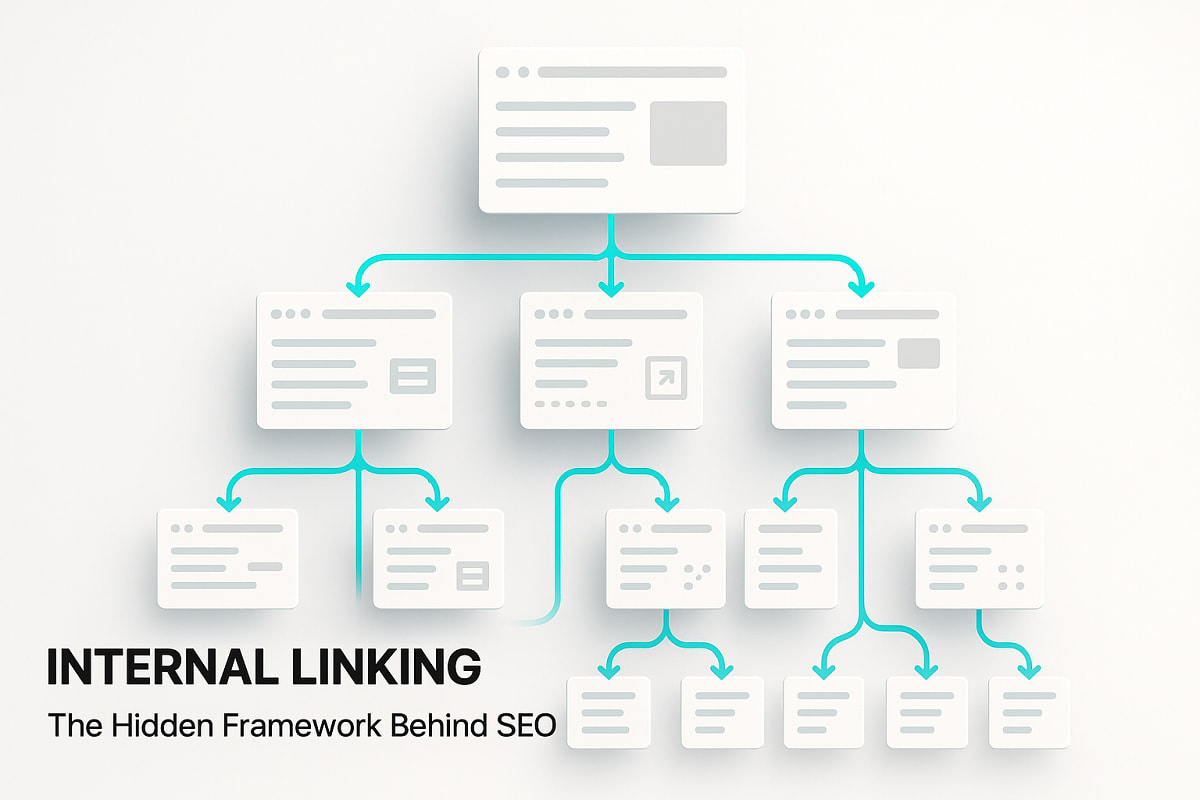
From a crawler’s perspective, internal links serve as navigational guides. From a ranking perspective, they distribute PageRank or link equity. And from a semantic perspective, they define contextual relationships among entities, topics, and supporting content.
Traditional SEO once focused mainly on link counts and anchor optimization. But as semantic search and AI-based ranking models evolved, the value of an internal link shifted toward meaning propagation, how the relationship between two linked pages adds depth to the overall site understanding.
A link from your “On-Page SEO Guide” to “Keyword Placement Strategy” is no longer just a crawl signal. It’s a semantic statement: these two ideas are connected in topic hierarchy.
Types of Internal Links and Their Strategic Roles
Not all internal links serve the same purpose, nor should they. Each type of link contributes differently to how information flows across your site. Some guide users and crawlers through your structure, while others create contextual relationships that define meaning. Understanding these types and their strategic intent is essential for optimizing not just for search visibility but for comprehension in the era of AI-driven search and entity-based indexing.
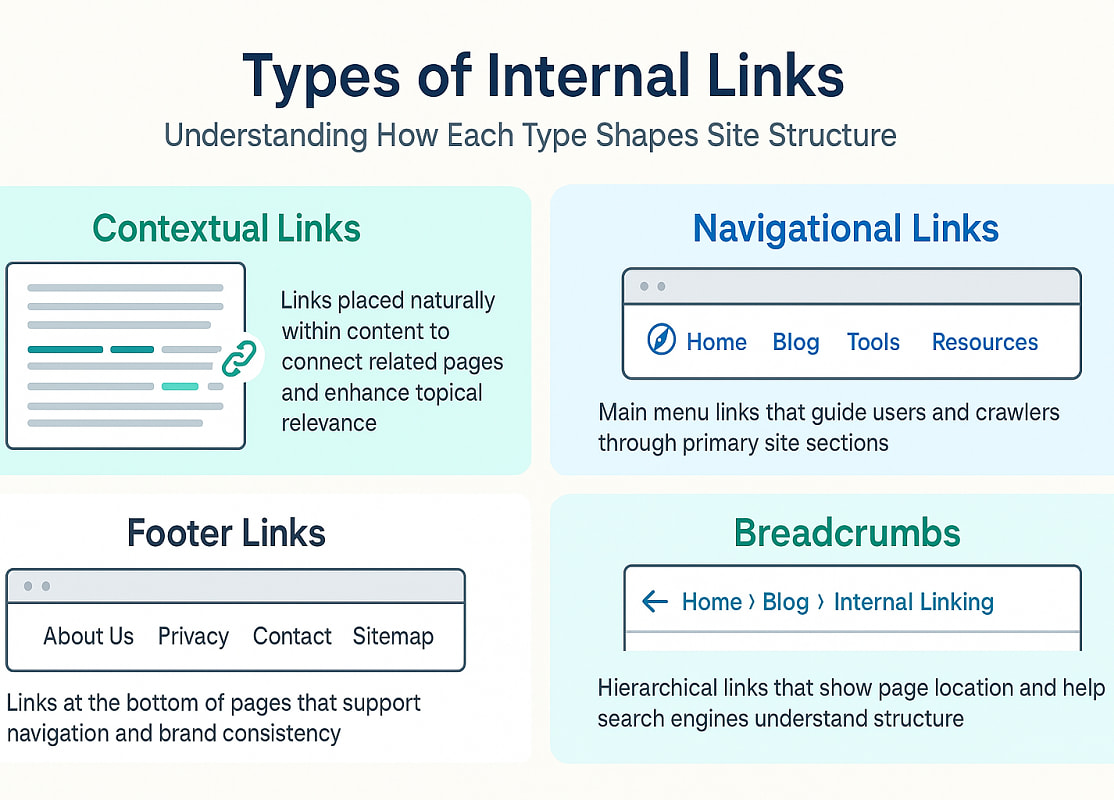
1. Contextual Links
Contextual links are the semantic bridges within your content, the naturally placed hyperlinks embedded in paragraphs that guide both readers and search engines from one idea to another. They are the most influential type of internal link in terms of SEO, entity association, and content comprehension.
When you link from an article on AI SEO Strategy to another on Entity Optimization Guide, you are not just connecting two pages; you are signaling a conceptual relationship. Search engines and AI crawlers interpret that link as an indicator that both pages belong to a related topic cluster or entity graph.
From an AI Search and GEO (Generative Engine Optimization) standpoint, contextual links help anchor semantic embeddings. The surrounding sentence context, anchor phrase, and target page content all contribute to a shared vector of meaning. This alignment helps search engines and large language models interpret how ideas interrelate across your site, increasing your likelihood of being surfaced in AI summaries or contextual answer results.
Pro Tip: Always link contextually within semantic proximity. Avoid mechanical linking and connect concepts that genuinely share informational or intent-based relevance.
2. Navigational Links
Navigational links are the structural backbone of your website. These include menus, sidebars, and category listings that shape how users and bots traverse your site. They help both humans and crawlers understand what your website is about and where its most important sections reside.
In traditional SEO, navigational links establish hierarchy and authority flow. Pages featured in main menus such as Home, Blog, Tools, or Resources are automatically recognized as top-level entities. Their prominence in site navigation conveys that these sections represent your core offerings or thematic hubs.
From an AI SEO perspective, navigational links also serve as semantic indexers. Generative and entity-aware engines interpret them as categorical clusters that organize meaning across your domain. For example, a “Resources” link connected to guides, tools, and case studies signals a “learning and utility” intent cluster, influencing how AI systems categorize your site contextually.
3. Footer and Utility Links
Footer links often carry less direct ranking weight, but their structural and brand-level significance is undeniable. Because footers appear on every page, their repetitive nature means search engines treat them as sitewide constants rather than contextual indicators. Yet, they serve crucial roles in both user experience and entity understanding.
A well-structured footer typically includes links such as About Us, Privacy Policy, Terms of Service, Sitemap, and Contact.
These links:
- Help AI-driven crawlers confirm your site’s organizational identity and authorship consistency
- Contribute to trust signals, which can influence E-E-A-T (Experience, Expertise, Authoritativeness, Trustworthiness)
- Provide redundancy for accessibility, helping users navigate to key areas without relying on the main menu
In an AI Search context, consistent footer linking improves how LLMs (large language models) interpret your site’s entity boundary, which defines where the brand starts and ends within its own web ecosystem. This subtle consistency aids in entity disambiguation and canonical understanding, especially for organizations managing multiple products or subdomains.
4. Breadcrumbs and Hierarchical Links
Breadcrumbs are more than navigation aids; they are semantic path markers that define how content fits within your site’s conceptual hierarchy. Typically displayed near the top of a page (for example, Home › Blog › On-Page SEO › Internal Linking), breadcrumbs show both users and search engines the parent-child lineage of your content.
For traditional SEO, breadcrumbs help search engines crawl more efficiently, offering secondary paths to deep pages and reinforcing category relationships.
In AI SEO and AEO (Answer Engine Optimization), their function expands because breadcrumbs serve as entity containment signals. They help generative engines such as ChatGPT or Gemini interpret which entities belong to which clusters, refining how your pages are grouped in AI responses and knowledge panels.
Pro Tip: Always link each breadcrumb level and ensure it matches both your URL structure and internal link strategy. Consistency reinforces your semantic web of meaning.
Each type of internal link; contextual, navigational, footer, and breadcrumb, serves a distinct strategic role. Contextual links shape meaning, navigational links define hierarchy, footer links convey trust and identity, and breadcrumbs clarify structure and lineage. Together, they form the multidimensional architecture that enables both users and AI systems to interpret your website not as a set of disconnected pages but as a cohesive, knowledge-connected entity.
How Search Engines Interpret Internal Links
Search engines have evolved from simply counting internal links to deeply analyzing their meaning and intent. Modern algorithms interpret links across multiple layers: structural, contextual, and semantic. Each internal link contributes to how search engines understand your website’s organization, entity relationships, and topical relevance.
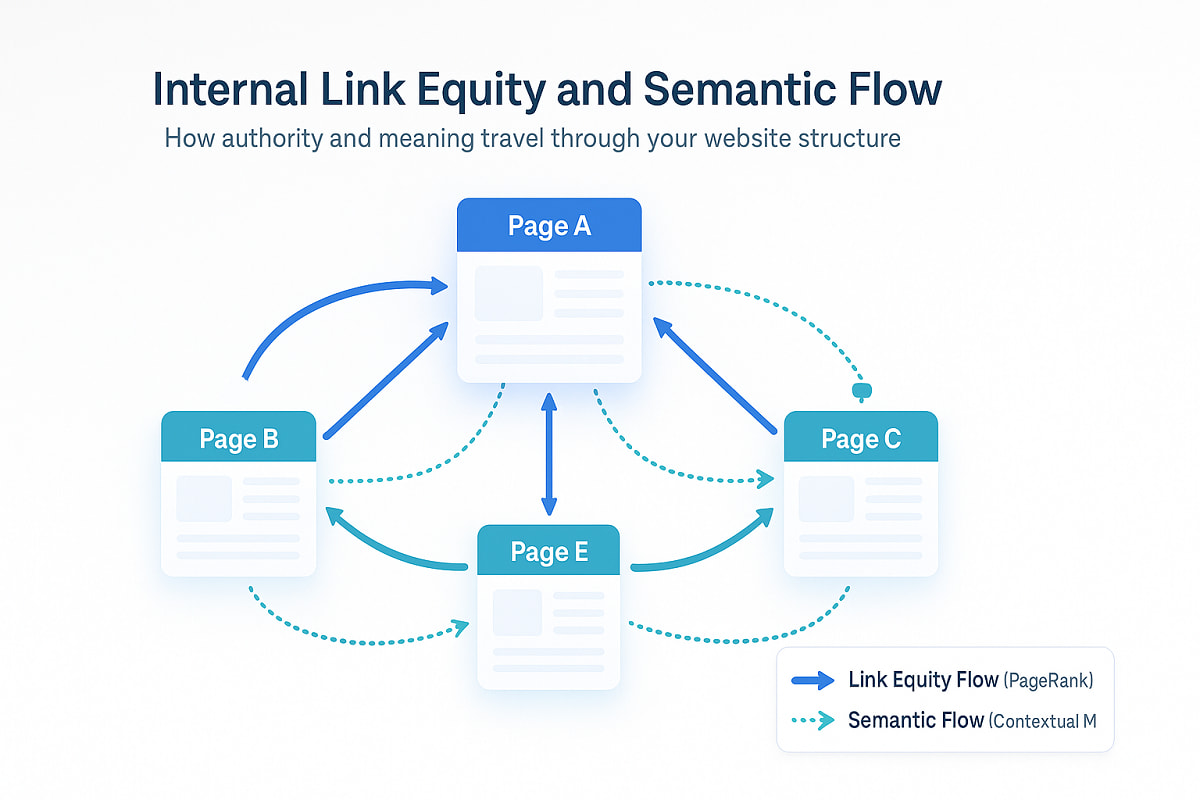
Internal linking now operates as both a ranking signal and a language of context. It helps search engines not only decide what to crawl but also what to understand within a site’s conceptual framework.
A. PageRank Distribution and Link Equity Flow
The earliest role of internal links was to distribute PageRank, the mathematical representation of a page’s authority. That principle still exists, but it now functions within a more complex interpretive layer. Search engines no longer evaluate internal links solely by count; they interpret how those links fit within topic relevance and intent alignment.
For example, a link from a high-authority page about Technical SEO to another page on Crawl Budget Optimization passes more than just numerical equity. It passes contextual authority, reinforcing the thematic relationship between the two topics. Conversely, a random or unrelated sitewide link offers little to no value because it fails to contribute meaning to the authority transfer.
Pages optimized with strong internal linking and precise Title Tags often retain more contextual authority. Together, they guide both crawlers and AI models toward understanding topic relevance and user intent.
Modern crawlers use link weighting models that combine traditional PageRank metrics with topical embedding similarity. This means search engines evaluate whether two linked pages share semantic proximity. If a link connects thematically inconsistent content, the equity transfer becomes weaker.
AI-driven crawlers like those powering Google’s and Bing’s modern systems use neural embeddings to measure this contextual distance. The more closely aligned the textual and entity signals are between two pages, the more efficiently link equity flows and the stronger both pages perform within their shared topic cluster.
B. Semantic Relationships and Entity Context
Internal links also act as semantic connectors that define relationships between entities and concepts. Modern search engines such as Google rely on their Knowledge Graph and Entity Understanding systems to interpret these connections. Each link can represent a potential semantic triple, a structured relationship that expresses meaning between two ideas.
For instance, when a page about Internal Linking links to Site Architecture Optimization, search engines may interpret that connection as:
Internal Linking → supports → Site Architecture Optimization
This relationship expresses both direction and intent, signaling that one concept enables or reinforces another. Over time, a site that consistently builds such structured connections can create its own internal knowledge graph, allowing search engines to see how topics, entities, and subtopics interrelate within your domain.
These internal semantic triples then align with external knowledge graphs such as Google’s. When your site’s conceptual relationships mirror the relationships already recognized in external graphs, it strengthens your entity authority and topic trust signals.
Practically speaking, this means:
- Internal links should be built between pages that share entities, attributes, or topical intent.
- Avoid linking unrelated concepts purely for navigational reasons, as it can dilute your site’s semantic clarity.
- Use anchor text that reflects the conceptual relationship, not just the keyword.
By shaping your internal links around entity relationships, you turn your website into a cohesive semantic ecosystem rather than a collection of standalone documents.
C. Crawling and Indexation Patterns
Internal links define how crawlers move through your website. They determine which pages are discovered, how often they are revisited, and how search engines prioritize them for indexing.
In a traditional sense, sites with shallow, well-linked architectures enable faster and more efficient crawling. Pages that are easily reachable within three clicks from the homepage tend to be indexed more consistently and refreshed more frequently.
However, modern crawling behavior has evolved to include semantic prioritization. AI-assisted crawlers do not rely solely on click depth or XML sitemaps. Instead, they assess semantic centrality; how conceptually important a page is based on its inbound internal links and the topical relevance of those links.
For example:
- If multiple pages within your On-Page SEO cluster link to Internal Linking Best Practices, crawlers recognize it as a hub of conceptual importance.
- Conversely, a page buried deep within your structure with few contextual inbound links will be seen as semantically isolated, even if technically accessible.
Crawl budgets are now partially guided by semantic weight. Pages that appear more central within their topic cluster receive more frequent crawl attention, improving their freshness and visibility in AI-generated results.
D. AI Understanding and Context Propagation
In the era of AI SEO, Generative Engine Optimization (GEO) and Answer Engine Optimization (AEO), internal linking serves a new and far-reaching function. Beyond guiding crawlers, it helps AI models understand and propagate context across your website.
Generative search systems such as ChatGPT, Perplexity, or Gemini analyze how topics interconnect to produce meaningful, multi-layered answers. Internal links are the semantic bridges that help these systems interpret the relationships between entities and the flow of knowledge within your content ecosystem.
For instance, when your Content Optimization page links to E-E-A-T Principles and Entity SEO, it forms a conceptual triangle. To an AI summarizer, that pattern implies that “Content Optimization” is closely related to both quality signals and entity alignment. This not only helps your content surface in generative responses but also ensures it is understood within the right semantic context.
In practical terms, internal linking now functions as context metadata for AI systems. It allows your content to be understood holistically, rather than as isolated fragments.
In GEO and AEO, internal links are not just crawl paths. They are meaning paths that connect your entities, reinforce your authority, and guide AI systems toward a unified understanding of your expertise.
Search engines no longer interpret internal links as simple directional connections. They view them as contextual, semantic, and structural frameworks that define how your website communicates meaning.From PageRank distribution to entity recognition and AI-driven comprehension, every internal link you create shapes how your site is understood and represented across both traditional and generative search landscapes. Mastering internal linking today means mastering how your content speaks to algorithms, not in keywords, but in relationships, context, and intent.
The Human Side of Internal Linking
SEO has always been a balance between algorithms and people. While internal linking often gets discussed in technical terms; crawl depth, PageRank, link equity its human dimension is equally critical. Search engines, after all, are designed to mirror user intent and satisfaction.
When visitors navigate a well-linked site, they stay longer, consume more pages, and build a deeper understanding of the brand or topic. That behavior; longer dwell time, reduced bounce rate, and increased session depth sends powerful engagement signals to search algorithms. In essence, good internal linking encourages human curiosity to move naturally through a digital ecosystem.
Think of it as designing a journey, not a route. Each link should serve a purpose helping a reader move from a surface topic to something deeper or more specific. A post on “On-Page SEO Fundamentals” might naturally lead to “Internal Linking,” and then toward “Entity Optimization” or “Schema SEO.” The navigation isn’t forced; it feels intuitive, just like following an expert’s train of thought.
Ultimately, internal linking should create momentum, an experience where users feel guided, not led.
Crafting an Effective Internal Linking Structure
An effective internal linking structure does more than connect pages; it reveals your website’s conceptual architecture. Search engines use it to understand how your ideas, products, and resources relate to one another.
The foundation of any well-structured site lies in hierarchy and cluster design.
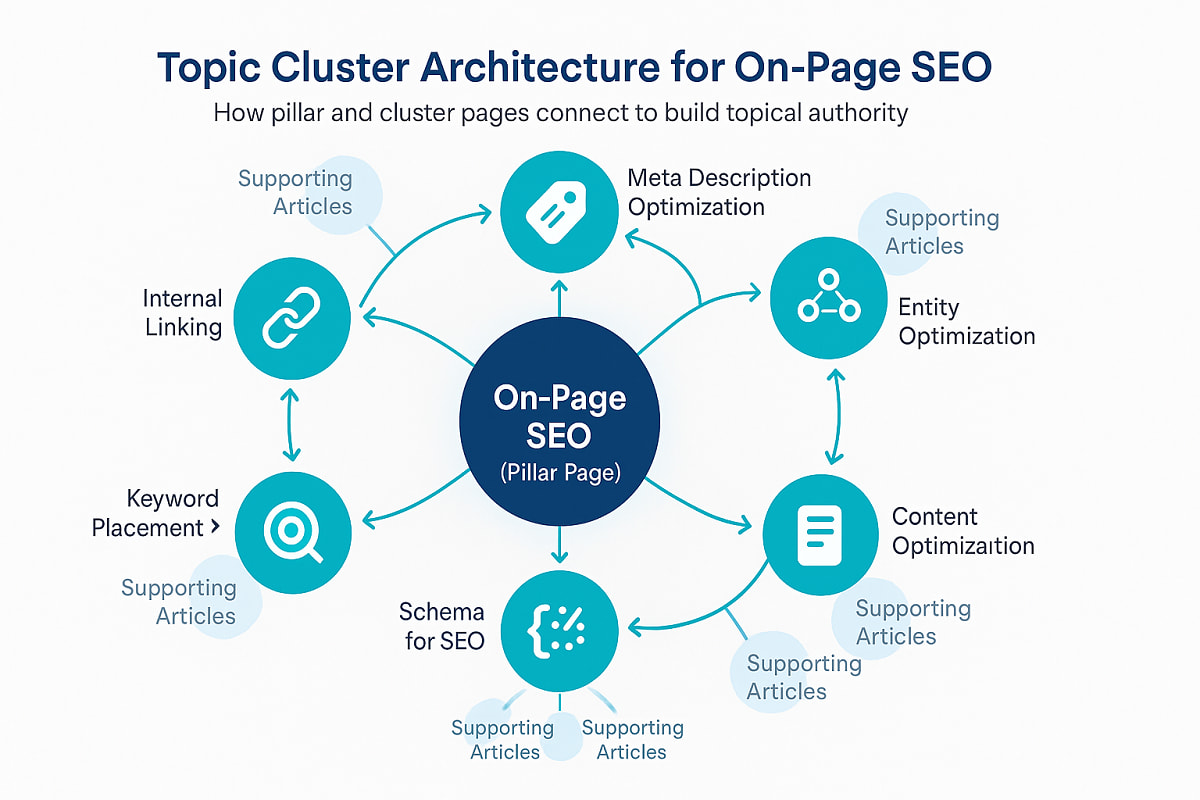
A. Hierarchical Site Architecture
At the top sits your homepage, followed by category or section pages, and then the supporting content. This logical hierarchy ensures that authority and relevance flow downward while signals and context flow upward.
For example:
/on-page-seo/
/on-page-seo/internal-linking/
/on-page-seo/keyword-placement-strategy/
Each URL reinforces topical clarity while keeping your entity relationships transparent.
B. The Topic Cluster Framework
The topic cluster model has become a modern standard for both SEO and AI understanding. A central pillar page (like “On-Page SEO”) connects to multiple cluster pages (“Internal Linking,” “Meta Descriptions,” “Content Optimization”), each linking back to the pillar.
This interconnection strengthens:
- Topical relevance: reinforces expertise and coverage depth
- Entity relationships: helps AI systems map thematic associations
- Crawl efficiency: ensures all related pages are frequently indexed
DefiniteSEO’s WordPress SEO Plugin, for instance, helps identify underlinked pages in clusters, a common gap in new SEO sites.
C. Anchor Text Strategy: Context Over Keywords
Anchor text is more than a clickable word; it’s a semantic connector. While keyword-rich anchors once drove rankings, AI systems now prioritize contextual diversity. When done right, anchor variety prevents over-optimization and enhances meaning propagation throughout your site’s entity graph.
Internal Linking for AI Search and Generative SEO (GEO & AEO)
The emergence of AI-driven search and Generative Engine Optimization (GEO) has reshaped how internal links influence visibility. Unlike traditional search, which ranked pages based on link authority, AI systems like ChatGPT, Perplexity, and Gemini interpret how information is interconnected semantically.
A. How AI Search Understands Relationships
AI engines rely on embeddings, numerical representations of meaning to understand relationships between concepts. Internal links serve as semantic bridges that help AI connect one vector space to another.
If your “Internal Linking” page frequently links to “Site Architecture Optimization,” “Entity SEO,” and “Topic Clustering,” those relationships signal to the AI that your content collectively defines an SEO knowledge domain.
In a generative query like “how do internal links help AI understand websites,” your site may appear in the synthesized response because the AI sees a coherent entity web rather than isolated pages.
B. Entity Connectivity and AI Summaries
AI systems build “entity graphs” where each concept (e.g., “Internal Linking,” “Schema,” “Content Optimization”) is a node, and every link forms an edge.
Strong, purposeful internal linking creates dense entity connectivity, improving your chances of being cited or summarized within AI-generated answers.
Generative models often extract relational patterns such as:
“Internal Linking → strengthens → Site Structure”
“Internal Linking → connects → Entities → improves → AI summarization accuracy.”
The more your internal links align with these conceptual relationships, the better your site fits into AI engines’ understanding of expertise and topical depth.
C. Structuring Internal Links for Generative Answers
When optimizing for Answer Engine Optimization (AEO), internal links should create complete meaning pathways.
For example:
- A pillar page on “AI SEO Strategies” should link to supporting pages like “Generative Optimization,” “Entity SEO,” and “Internal Linking.”
- Each supporting page should reciprocate, linking contextually back to the pillar.
This circular structure helps generative models summarize your content accurately without losing context. It’s the AI-era version of SEO synergy.
Data-Driven Internal Linking: Using Tools and Metrics
While creativity drives linking strategy, data ensures precision. Internal linking can be measured, audited, and optimized and data-driven insights often reveal hidden opportunities that intuition alone can’t.
A. Identifying Orphan and Underlinked Pages
Orphan pages, those with no internal links represent missed opportunities for authority distribution. Tools like DefiniteSEO’s Online SEO Checker, Screaming Frog, and Ahrefs can quickly detect these pages and visualize link flow.
The goal isn’t just to link everything; it’s to connect pages that share semantic or hierarchical relationships. Each link reinforces the site’s entity structure.
B. Analyzing Link Flow and Authority Distribution
Internal link analysis tools measure inlink count, crawl depth, and PageRank flow. But a more advanced approach is semantic link scoring, identifying whether internal links support the same topic cluster or dilute it.
A content-heavy site should ensure its most authoritative pages also serve as link hubs for related subtopics.
C. Practical Tools and Implementation
DefiniteSEO’s WordPress Plugin can automatically suggest contextual link opportunities based on semantic relevance; identifying places where entity overlaps exist between posts.
It complements this by flagging low-linked pages and helping maintain a consistent topic hierarchy, especially useful for scaling content-heavy blogs or e-commerce stores.
D. Measuring Impact
Track performance using:
- Changes in average position for targeted queries
- Increases in crawl frequency (via Search Console)
- Session depth improvements in analytics
- Growth in semantic keyword visibility (entity-based metrics from tools like InLinks or Clearscope)
Over time, these metrics confirm how well your linking structure supports both traditional and AI-driven ranking systems.
Advanced Strategies for Modern Sites
As websites grow, internal linking requires both strategy and scalability. Different site types demand nuanced approaches.
A. E-Commerce: Product-Category-Entity Flow
In e-commerce SEO, internal linking determines how product and category pages share authority.
For example:
- Product pages link upward to parent categories (“Running Shoes”) and laterally to related entities (“Sports Accessories”).
- Category pages link down to top-selling or featured items, reinforcing commercial intent.
This bi-directional linking helps AI systems map relationships between product entities, brands, and attributes, improving visibility in shopping and AI-based recommendation engines.
B. Blogs and Knowledge Hubs
For content-driven sites, internal links should strengthen topical silos while maintaining natural flow.
A “Content Marketing” pillar page might link to:
- “Content Optimization Frameworks”
- “Entity-Based Keyword Research”
- “Internal Linking for SEO”
Each connection builds a semantic neighborhood, a group of interlinked articles that define a single domain of expertise.
C. AI-Assisted Linking Recommendations
AI tools are rapidly improving at identifying potential internal links through natural language embeddings.
DefiniteSEO’s upcoming Content AI can read through articles, detect related entities, and recommend link insertions that strengthen semantic clustering, automating a task that once required hours of manual analysis.
When combined with editorial oversight, AI-assisted linking doesn’t replace human strategy; it scales it with precision.
Common Mistakes and Misconceptions
Even with the best intentions, many SEO practitioners misapply internal linking, either overdoing it mechanically or underusing it strategically. These mistakes often stem from outdated practices that no longer align with how modern search and AI systems interpret meaning.
A. Over-Optimization and Anchor Repetition
One of the oldest and most persistent issues is anchor text repetition. In the past, repeating the same exact-match anchor across multiple pages was considered beneficial for keyword reinforcement. Today, it’s a clear signal of artificial optimization.
AI ranking systems value semantic diversity over uniformity. Using natural variations such as “optimize your internal links,” “learn internal linking strategy,” and “internal link best practices” builds a more authentic contextual footprint.
B. Ignoring Deep Pages
Another common oversight is focusing internal linking only on top-level or commercial pages. Deep informational pages, case studies, glossaries, research insights often hold valuable topical authority that remains buried due to lack of internal references.
These deep pages can strengthen your site’s semantic core, offering contextual signals that boost related surface-level pages. An effective internal linking audit should identify such underlinked opportunities and bring them forward.
C. Flat Architecture Fallacies
Some SEOs pursue “flat” architecture, making every page accessible within a few clicks. While crawl depth matters, flattening the hierarchy too aggressively can blur topical relationships.
Search engines and AI models rely on structured hierarchy to understand parent-child semantics. If every page links to every other page, your topical map becomes incoherent. A balanced approach, where cluster and pillar relationships remain defined, supports both crawl efficiency and entity clarity.
D. Ignoring Context Surrounding Links
A link’s power is not in isolation but in context. Surrounding text provides the semantic environment that AI uses to interpret the purpose of a link. Randomly inserted anchors at the end of paragraphs offer little contextual value.
Embedding links naturally within conceptually relevant sentences not only improves readability but also strengthens AI’s ability to infer topic relationships.
How to Audit and Maintain Internal Links
A well-planned internal linking strategy can degrade over time if not monitored. Pages are deleted, URLs change, and content grows faster than linking logic can keep up. Regular audits ensure your structure continues to support both SEO and AI optimization goals.
A. Setting Up a Regular Link Audit Routine
A quarterly or biannual audit is ideal for most websites. Start by exporting all internal link data using tools like DefiniteSEO’s Online SEO Checker, Screaming Frog, or Ahrefs.
Look for:
- Broken internal links (404s or 410s)
- Redirect chains that reduce crawl efficiency
- Orphan pages with zero inlinks
- Overlinked hubs diluting contextual flow
B. Handling Broken or Redirected Links
Every redirect adds friction for crawlers. Where possible, update links directly to final destinations instead of relying on 301s.
If a key page has been removed, replace links with the closest semantic alternative. This keeps contextual relationships intact even when URLs change.
C. Updating Links During Content Refreshes
Whenever you refresh or expand a piece of content, revisit its internal links. The topical context may have evolved, for instance, a post originally about “SEO Tools” might now include discussions on “AI Search Optimization.”
Adding or updating internal links keeps your semantic graph dynamic and aligned with evolving content relevance.
D. Automating Maintenance with Intelligent Tools
DefiniteSEO’s WordPress Plugin simplifies this process by automatically detecting broken links and underlinked pages, providing real-time suggestions to improve internal connectivity.
Pairing automation with manual oversight ensures every new content addition reinforces your overall architecture.
Real-World Example: Building an Internal Linking Framework
Let’s walk through how a content-rich site can build and scale an effective internal linking system.
Scenario: A SaaS company publishes weekly content about SEO automation, AI content generation, and digital marketing strategy. Over time, they accumulate 200+ posts, but traffic plateaus.
Step 1: Content Mapping
They begin by mapping content by topic and entity:
- Pillars: On-Page SEO, Technical SEO, AI SEO
- Clusters: Internal Linking, Schema Optimization, Entity SEO
- Supporting Posts: Case studies, how-tos, definitions
The map visually highlights disconnected pages, especially older posts that lack links from newer, high-performing articles.
Step 2: Internal Link Realignment
Next, they connect semantically related pages:
- “AI SEO Strategies” → “Entity Optimization for AI Search”
- “Schema and Rich Results” → “Understanding Structured Data Types”
- “Internal Linking” → “Topic Cluster Frameworks”
Within two months, crawl frequency on updated pages increases, and Search Console shows higher impressions for entity-rich terms like “semantic SEO” and “AI-driven search optimization.”
Step 3: Automation Integration
They deploy DefiniteSEO’s Content AI to identify emerging link opportunities automatically. The system detects overlaps between new and existing content, suggesting natural link placements based on contextual alignment.
The result:
- 37% increase in organic traffic to deep pages
- 22% faster indexation for new content
- Enhanced inclusion in AI summary snippets and answer boxes
This demonstrates how strategic, data-driven linking elevates both human usability and AI comprehension.
Internal Linking in the Era of Entity SEO
Entity SEO has transformed the way search engines interpret meaning, context, and relationships between pieces of content. Instead of treating a website as a collection of pages, search systems now view it as a network of interconnected entities. Within this network, internal linking plays a central role. It reveals how topics relate to one another and how your content contributes to the broader knowledge landscape that powers modern search and AI summarization.
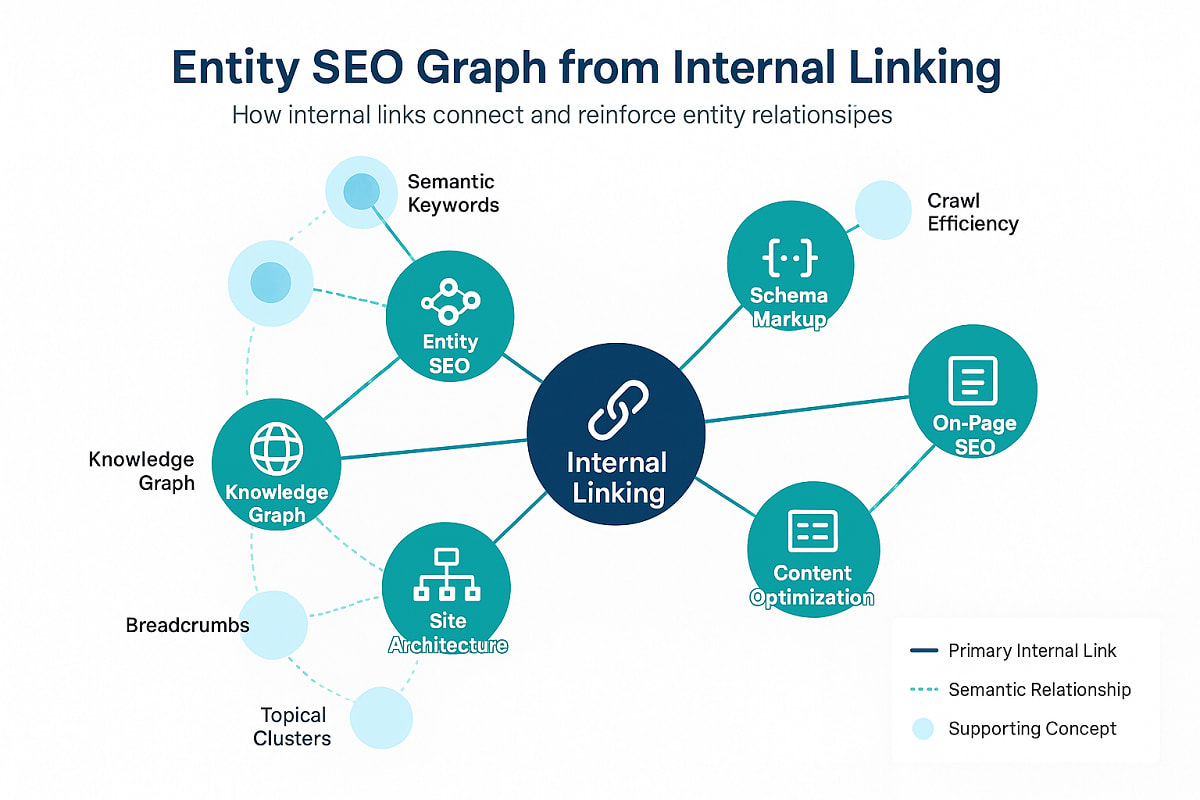
In the Entity SEO model, internal links are not just navigational or structural tools. They are semantic connectors that define how concepts interact within your domain. Every link you place helps search engines build a clearer picture of your expertise, topical depth, and conceptual boundaries.
A. Connecting Topics, Entities, and Relationships
In the world of Entity SEO, every indexed page can be treated as an entity. Each entity represents a specific idea, object, or concept such as “Internal Linking,” “Site Architecture Optimization,” or “AI SEO Strategy.”
When you create links between these entities, you are effectively teaching search engines how those ideas relate to one another. Internal links make these relationships explicit, transforming your site into a structured network of meaning.
For example:
- Internal Linking → connects → Site Architecture Optimization
- Internal Linking → supports → AI SEO Strategy
- Internal Linking → explains → Crawl Budget Optimization
Each of these statements forms what search engines recognize as a semantic triple. A semantic triple is a relationship between two entities defined by a verb or connector that provides meaning. It is expressed in the format: Entity A – Relationship – Entity B.
By consistently creating meaningful internal links, your website begins to generate hundreds of these semantic triples, forming a structured internal knowledge graph.
Over time, this internal graph begins to align with external graphs such as Google’s Knowledge Graph. This alignment helps establish your domain as an authority within specific topics because your internal relationships reinforce the same conceptual structures that search engines use to understand the web.
When done correctly, your internal links communicate meaning rather than just movement. They signal to search engines not only what your site is about but also how it thinks, how each idea supports or explains another.
B. Internal Links as Knowledge Graph Reinforcers
Search engines and AI-driven systems maintain vast knowledge representations of the web. These are dynamic graphs that connect entities, topics, and attributes across domains. When your internal links consistently connect related concepts, they serve as reinforcers that help AI models validate your expertise and conceptual accuracy.
Within your website, this process mirrors the structure of a knowledge graph. Every time you link from one entity-rich page to another, you strengthen both nodes by making the relationship explicit. Over time, this interconnected structure becomes a domain-level knowledge graph that communicates depth, authority, and semantic clarity.
For example, linking your article on Entity SEO to one on Knowledge Graph Optimization creates a visible relationship between two semantically aligned concepts. When search engines observe this pattern repeatedly across multiple pages, they infer that your website offers topical completeness within that subject area.
This reinforcement has measurable benefits:
- It increases your site’s entity-level authority, improving visibility in topic-related searches.
- It boosts your chances of being cited or referenced in AI-generated summaries, since your domain’s relationships are clearly defined.
- It supports Answer Engine Optimization (AEO) by giving AI summarizers logical pathways to extract contextually coherent answers.
Consistent entity-level linking allows search engines to trust your site as an organized, reliable source of interconnected information. Instead of being a collection of isolated articles, your site becomes a coherent knowledge system that can be mapped and interpreted at scale.
C. Example of Entity Connectivity
To visualize this concept, imagine a section of your site dedicated to AI SEO. The internal linking within that section could be structured as follows:
AI SEO (pillar)
├── Entity SEO
├── Generative Optimization
├── Internal Linking
└── AI Content Optimization
Each of these subtopics is not only linked to the pillar but also to one another through contextual anchors. For example, Entity SEO might link to AI Content Optimization within a paragraph discussing context-based generation, while Internal Linking might reference Generative Optimization within a section on information flow.
This interconnected structure allows both users and search engines to traverse a conceptual network, rather than a simple hierarchical navigation tree. The pattern forms a web of understanding where each page supports and enhances the meaning of others.
For human users, this structure improves discoverability and engagement by making it easy to move through related ideas. For AI engines and knowledge systems, it defines a semantic ecosystem where entities are understood in relation to one another.
When search systems see such internal connectivity, they interpret your site as an integrated, entity-aware environment. This increases your site’s alignment with Entity SEO principles, which focus on relevance, completeness, and relationship accuracy.
Entity SEO shifts the focus of optimization from keywords to relationships between entities.
Internal linking is one of the most powerful tools for expressing those relationships. It defines how your topics connect, how your authority spreads, and how search engines interpret your expertise at a conceptual level. When you link entities intelligently, you are not just improving navigation, you are teaching search engines how your knowledge connects, allowing your website to become an authoritative, entity-rich network of meaning.
Future of Internal Linking: From SEO to AI SEO
Internal linking is evolving from a simple navigational and ranking tactic into a semantic communication system between websites and AI-powered search engines. The future of optimization will no longer be about counting links or matching keywords but about defining meaning and relationships in ways machines can interpret accurately.
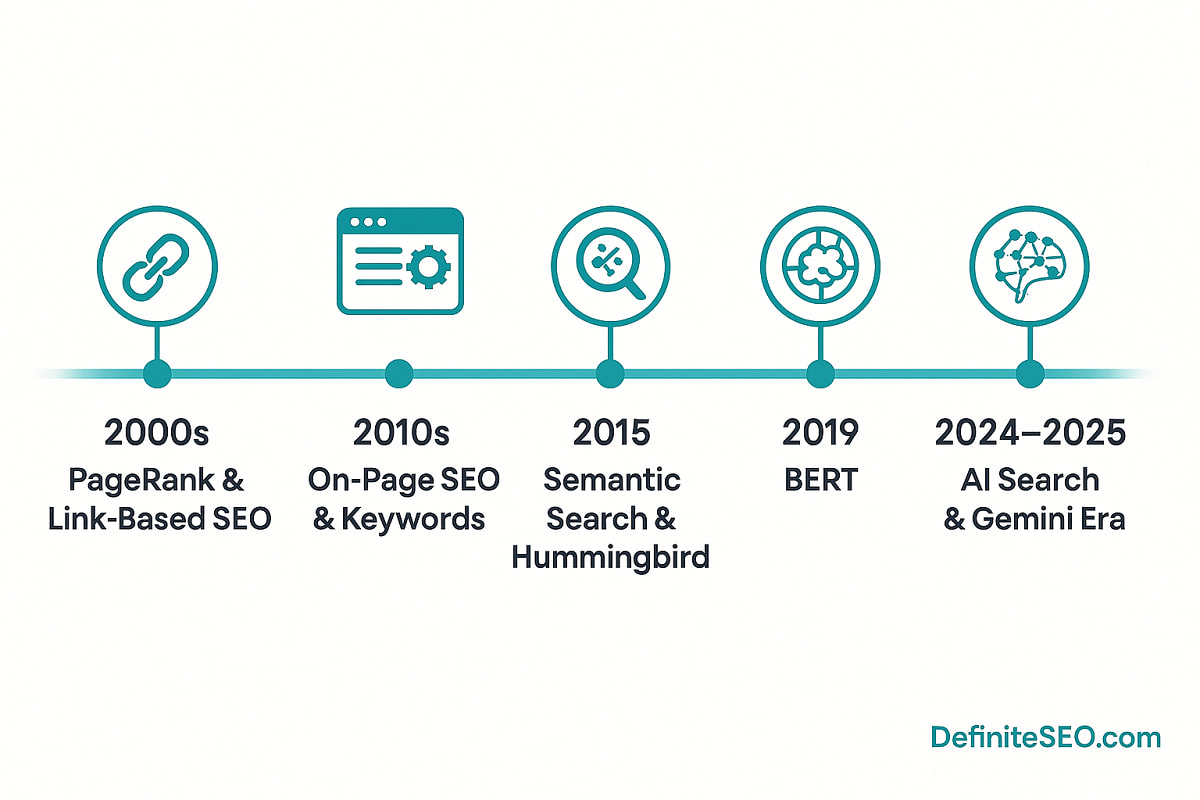
As Generative Search and Answer Engines become the primary layers of discovery, the structure of your internal links will directly influence how your content is understood, synthesized, and surfaced. The shift from SEO to AI SEO means that internal links will function as contextual signposts that guide both crawlers and language models toward relevance and credibility.
Below are four key transformations shaping the future of internal linking.
A. Predictive Linking with AI
The next stage of internal linking will be predictive rather than reactive.
Future content management systems, aided by AI, will analyze your site’s entities, topics, and semantic relationships in real time. Before a page is even published, an AI model will predict the most contextually relevant internal links based on entity embeddings and topic vector similarity.
These systems will understand how a new article fits within your domain’s conceptual ecosystem. For example, when you begin drafting an article about Generative Optimization, the AI will automatically suggest links to Entity SEO, Content Optimization, and Internal Linking pages, all identified as semantically related through your existing entity graph.
This predictive linking will not only save time but also improve precision. Instead of relying on manual memory or keyword overlap, the AI will recommend connections that align with topical proximity, intent alignment, and knowledge graph structure.
As a result, internal linking will become part of a continuous feedback loop. The AI will monitor which links drive engagement and refine its future suggestions, ensuring your internal network remains dynamic and contextually accurate over time.
B. Adaptive Anchor Systems
Anchor text, long considered a static on-page element, is poised to become dynamic and adaptive in the AI SEO era. The future may introduce context-sensitive anchors that change automatically based on user intent, query type, or even device environment.
Imagine a single hyperlink whose anchor text is not fixed but responsive to context.
When a desktop user reads an article on On-Page SEO, the link might display as “Internal Linking Strategies.”
In contrast, the same link could appear in an AI-generated summary as “How pages connect semantically within a site.”
Both point to the same destination but adapt their descriptive surface to fit the context of the interaction.
This dynamic system could be powered by AI language models that interpret how best to phrase an anchor depending on the query intent and the conversational tone of the search interface. It would transform internal links from static references into living semantic connectors that communicate meaning differently across platforms and devices.
Moreover, adaptive anchors could integrate with personalization data. For instance, a returning user reading advanced SEO material might see “Entity-level internal linking,” while a beginner might see “Learn how to link your pages effectively.”
C. Internal Linking as a Ranking Context
In traditional SEO, internal links help distribute PageRank and signal importance. In AI SEO, they define contextual authority. AI search systems do not only rank individual pages; they rank clusters of meaning. Internal links determine which clusters of content best represent a given topic within a query scenario.
Each time you connect two semantically aligned entities, you help AI systems understand the scope and depth of your topical coverage. This turns your site from a collection of articles into a context provider, a structured knowledge environment that algorithms can trust when synthesizing answers.
For example, a search engine processing a user query like “best methods for optimizing content entities” might not display a single page result. Instead, it might reference multiple interconnected pages from your site because your internal linking structure clearly outlines a conceptual hierarchy between “Entity SEO,” “Content Optimization,” and “Schema Markup.”
The better your internal links articulate those relationships, the more likely your domain is to appear in context-based citations, AI snippets, or generative responses.
D. The Human-AI Balance
Although AI will automate much of the technical and analytical work behind internal linking, the human element will remain essential. Algorithms can identify relationships, but they cannot fully interpret narrative intent, emotional tone, or reader psychology.
Editors, strategists, and writers will still decide why a link belongs in a particular place, how it fits the story, and what experience it should create. A human understanding of flow, readability, and user empathy ensures that linking enhances comprehension rather than interrupting it.
The most successful SEO teams of the future will integrate AI-assisted automation with editorial strategy. AI will suggest links based on embeddings and entity graphs, while human editors will refine those choices to reflect user purpose and brand voice.
This synergy will create internal linking structures that are both algorithmically optimized and emotionally coherent.
AI may understand the relationship between “Entity SEO” and “Knowledge Graph Optimization,” but a human strategist knows when and how that connection adds value within the context of a narrative.
Internal linking is entering a new era where meaning replaces mechanics.
As AI search engines evolve to understand language, entities, and relationships more deeply, the way your pages connect will define how your brand is interpreted by algorithms and users alike.In the coming years, your internal link architecture will become a form of semantic communication — a way of teaching AI systems what your content means, not just where it is located. Predictive systems will build links in real time, anchors will adjust dynamically to intent, and your site’s entity graph will function as an evolving map of expertise.Internal linking, once a tactical task, will become a strategic language of context. Those who master it will not just rank higher; they will become part of how AI understands the web.
Best Practices Checklist
Internal linking isn’t just a technical exercise, it’s a system of meaning, navigation, and authority. As your site scales, this checklist ensures your internal linking remains strategically aligned with both SEO and AI-driven search evolution.
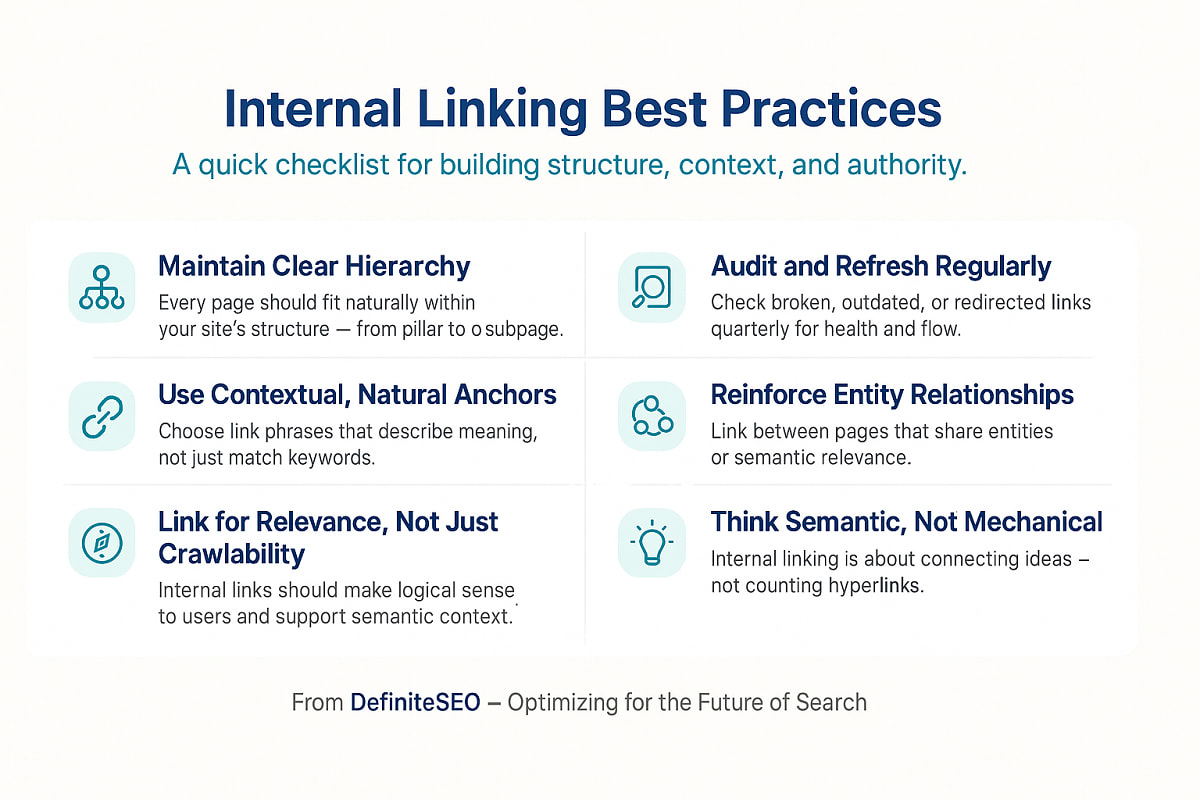
Structural Best Practices
- Maintain a clear hierarchy. Define primary, secondary, and supporting pages in a logical pyramid structure.
- Build topic clusters. Each major topic (e.g., On-Page SEO) should link to and from its related clusters (e.g., Internal Linking, Keyword Placement, Entity Optimization).
- Keep crawl depth under three clicks. Ensure essential content is always easily reachable for users and bots.
Contextual & Semantic Practices
- Use natural anchors. Favor meaningful, varied anchor phrases over keyword repetition.
- Prioritize semantic relationships. Link between thematically related content, not just pages with similar keywords.
- Add contextual support. The text around each link should reinforce relevance and meaning.
- Link intent to entity. Each link should clarify an entity connection (product → use case, etc.).
Performance & Maintenance
- Audit quarterly. Identify broken links, redirects, or orphaned pages using a tools.
- Balance link flow. Avoid overlinking high-authority pages while leaving others underlinked.
- Update with purpose. When adding new content, link to older articles where contextually relevant and vice versa.
When applied consistently, these best practices don’t just improve rankings, they future-proof your content structure for AI-driven discovery and retrieval.
FAQs
How many internal links should I add to a page?
There’s no fixed number, the key is context relevance. A 1000-word article might have 3–6 internal links if they genuinely support the topic. Focus on linking where it enhances understanding or connects entities meaningfully.
Should I use “nofollow” on internal links?
Generally, no. Internal links should remain dofollow to allow PageRank and semantic context to flow freely. “Nofollow” may be reserved for low-priority pages such as login or checkout screens that don’t need indexing.
How do I find orphan pages on my site?
Use DefiniteSEO’s WordPress Plugin or any other suitable tools to identify pages with zero inbound internal links. Orphan pages don’t benefit from site authority and are often missed by crawlers.
What’s the ideal anchor text strategy for AI SEO?
Use natural, descriptive phrases that reflect the relationship between the linked pages. Avoid repetitive keyword anchors, instead, think of anchors as contextual cues for both users and AI summarizers.
Can too many internal links hurt rankings?
Yes, excessive linking can dilute link equity and overwhelm both users and crawlers. Keep links relevant and meaningful. Overlinked pages can appear spammy, reducing clarity for semantic indexing systems.
How does internal linking influence AI summaries or answer engines?
Generative engines like ChatGPT or Perplexity analyze semantic connectivity, not just text. Well-linked clusters increase your chances of inclusion in AI-generated summaries because they show topical depth and relational authority.
How often should internal links be audited?
A quarterly audit is sufficient for most sites. For dynamic or content-heavy websites, monthly checks ensure link freshness and structural consistency.
What’s the best way to start improving internal links on an existing site?
Start small, identify your top-performing pages and ensure they link to relevant, underlinked content. Use tools to visualize link flow and gradually expand coverage toward a balanced sitewide structure.